
The Aizoaceae, or fig-marigold family, is a large family of dicotyledonous flowering plants containing 135 genera and about 1800 species. They are commonly known as ice plants or carpet weeds. They are often called vygies in South Africa and New Zealand. Highly succulent species that resemble stones are sometimes called mesembs.

Gasteria is a genus of succulent plants, native to South Africa and the far south-west corner of Namibia.
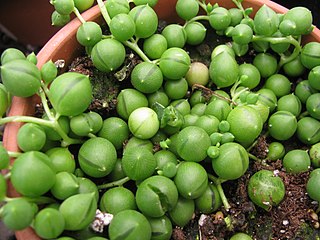
Curio rowleyanus, syn. Senecio rowleyanus, is a flowering plant in the daisy family Asteraceae. It is a creeping, perennial, succulent vine native to the Cape Provinces of South Africa. In its natural environment its stems trail on the ground, rooting where they touch and form dense mats. It often avoids direct sunlight by growing in the shade of other plants and rocks. It is commonly known as string-of-pearls or string-of-beads.
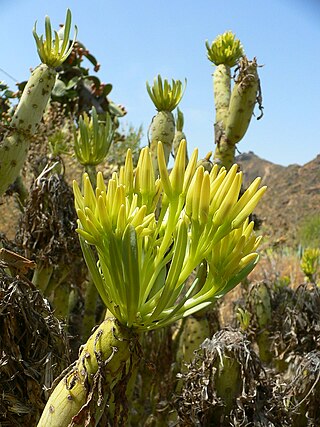
Kleinia is a genus of African flowering plants in the sunflower family. Kleinia contains around 50 species and is distributed from the Canary Islands, throughout Tropical Africa to India and Arabia. It is closely related to the genus Senecio but is distinguished primarily by having succulent stems or leaves.

Bulbine is a genus of plants in the family Asphodelaceae and subfamily Asphodeloideae, named for the bulb-shaped tuber of many species. It was formerly placed in the Liliaceae. It is found chiefly in Southern Africa, with a few species extending into tropical Africa and a few others in Australia and Yemen.

Tylecodon is a genus of succulent plants in the family Crassulaceae, native to southern Africa.

Drosanthemum ("dewflowers") is a genus of succulent plants in the ice plant family native to the winter-rainfall regions of southern Africa, including Namibia and the Cape Provinces and Free State of South Africa. Most species bear colorful flowers.
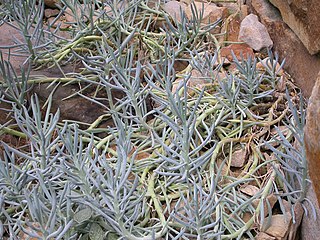
Curio ficoides, syn. Senecio ficoides, also known as skyscraper Senecio and Mount Everest Senecio, is a species of succulent plant, in the genus Curio (Asteraceae), indigenous to South Africa.

x Senecurio kleiniiformis is a hybrid species of flowering plant in family Asteraceae. It has been placed in either the genus Senecio, as Senecio × kleiniiformis, or Kleinia, but is now thought to be a hybrid between an unknown species of Curio and Senecio tropaeolifolius. It was initially named Curio × kleiniiformis, but in 2020 the hybrid genus Senecurio was created for it.

Curio archeri, syn. Senecio toxotis is a species of succulent plant in the family Asteraceaethat is indigenous to the south-western Cape, South Africa.
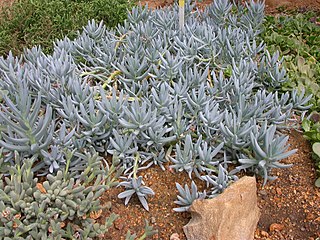
Curio repens is a species of succulent groundcover plant in the genus Curio, in the Asteraceae family. Visually-similar to the ice plants of Mesembryanthemum, or “mesembs”, C. repens is typically found growing in and among rocky crevices and exposed ledges on dry, rubble-strewn sandstone slopes, where drainage is swift and sun exposure and airflow is high. Commonly named blue chalksticks, blue chalk fingers or simply “blue iceplant”, it is frequently used in Mediterranean climate landscaping and as an ornamental plant.

Curio × peregrinus, also known as dolphin necklace, flying dolphins, string of dolphins, dolphin plant or Senecio hippogriff, is a succulent nothospecies of Curio in the family Asteraceae. It is often called, incorrectly, Senecio peregrinus, but that name was previously given, by Grisebach in 1879, to a different species from South America. The name Curio × peregrinus was published in 1999, based on the earlier name Kleinia peregrina; however, this name was not validly published. The plant is a hybrid between Curio rowleyanus and Curio articulatus.

Curio herreanus, syn. Senecio herreanus, which is also known as string of watermelons, string of beads, gooseberry plant and string of raindrops, is a flowering succulent plant in the daisy family Asteraceae that is native to Namibia. It is grown as an ornamental plant and is very similar in appearance to 'string of pearls', where the names may be conflated.
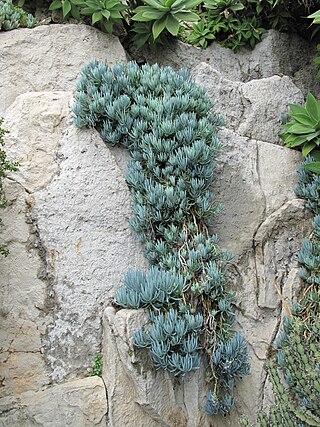
Curio talinoides, syn. Senecio mandraliscae, also known as blue straws, blue chalksticks, dassieharpuis, or narrow-leaf chalk sticks, is a succulent plant of the family Asteraceae that is native to South Africa. The origin of this plant is dubious and it may be a hybrid.

Curio crassulifolius, also known as blue fingers, is a succulent in the family Asteraceae that is native to South Africa.

Stoeberia is a genus of flowering plants belonging to the family Aizoaceae.
















